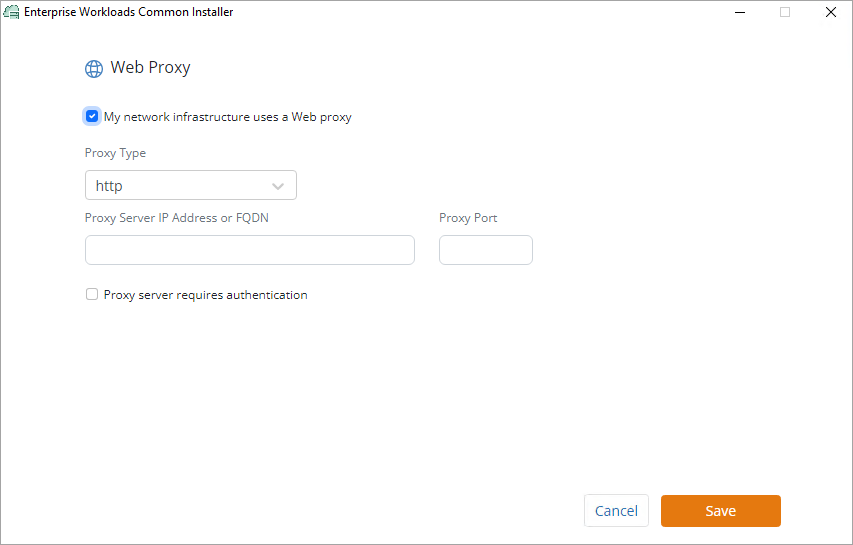Add and activate a NAS proxy
 Business
Business  Enterprise
Enterprise  Elite
Elite
This article describes how to install and activate a NAS proxy through the Management Console. Registering a NAS Proxy is the first step towards configuring Druva to back up a NAS share. Registering a NAS proxy involves:
Considerations for adding a NAS proxy
Druva supports backups of SMB and NFS shares. Install the NAS proxy on:
- A Windows server to back up SMB shares.
- A Linux server to back up NFS shares.
Step 1: Installing a NAS proxy
- Log in to the Management Console.
- Select the workload from the Protect menu. Note that if the All Organizations menu is enabled, you have to first select an organization where you want to add the NAS proxy, and then select the workload.
- The Get Started page is displayed if no NAS devices have been configured so far. On the Get Started page, under Register a NAS proxy, you will see No Proxy Registered. Click Add Proxy.
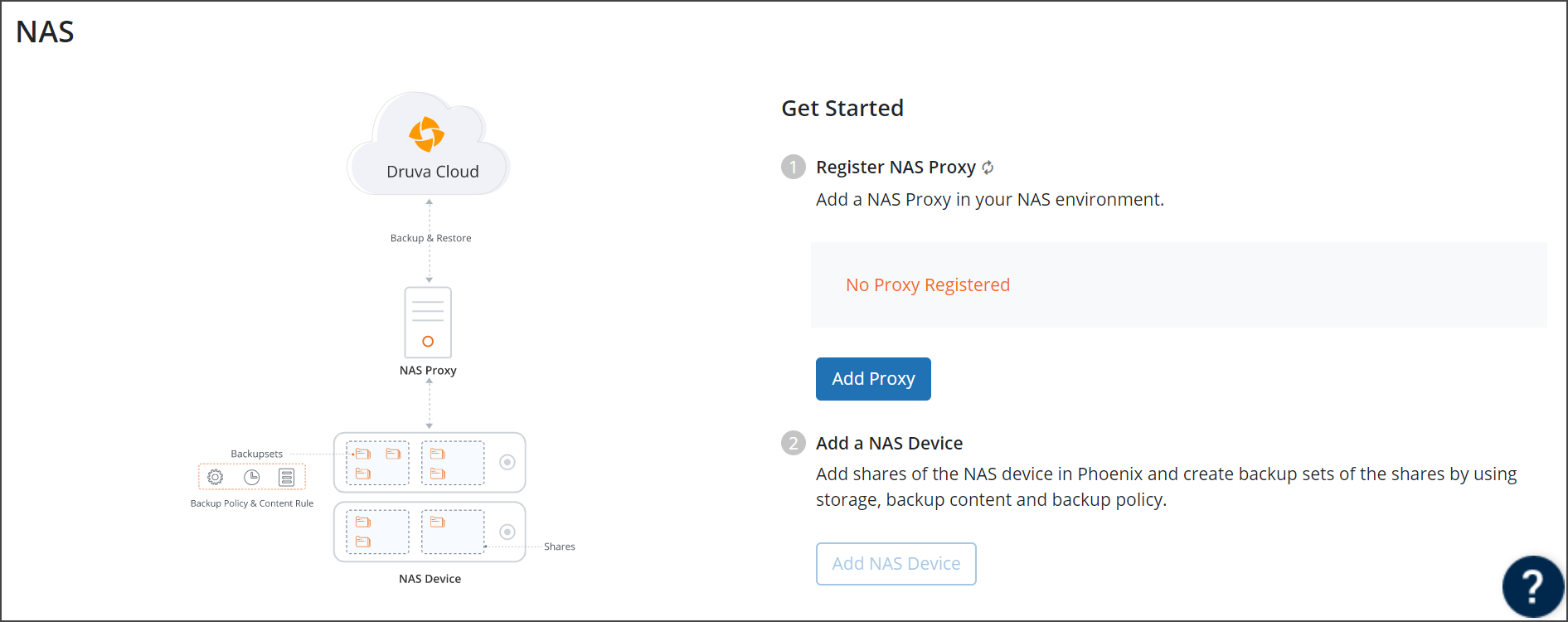
If NAS proxies and NAS devices have already been configured, you can add more proxies. In the left navigation pane, click All Proxies, and click Add Proxy.

- In the Add NAS Proxy dialog box, click Check Prerequisites and ensure that the server meets the prerequisites for the NAS proxy installation.
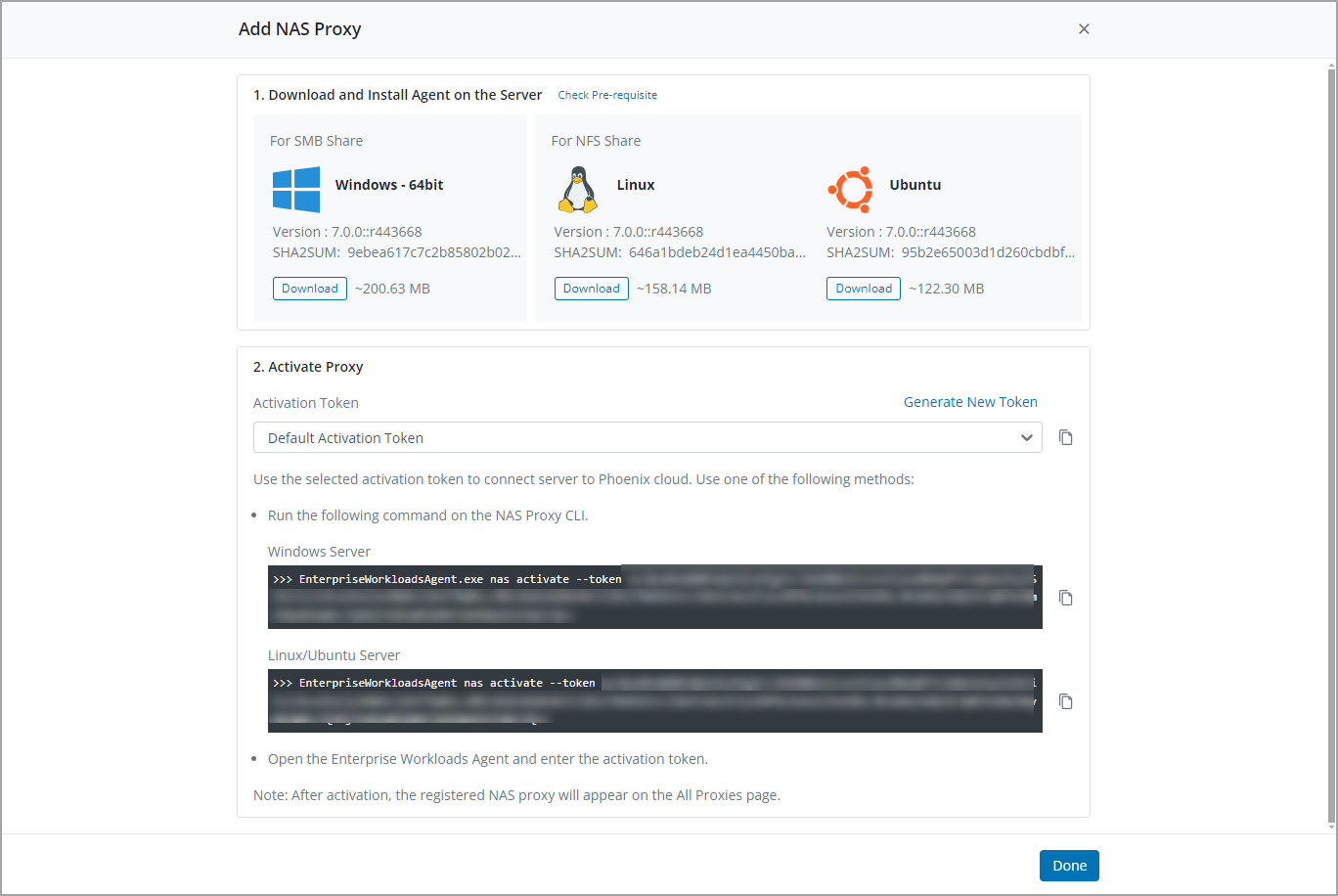
- Depending upon the type of share that you want to back up, download the agent on the Windows/Linux server that will act as the NAS proxy.
Note: Using this Hybrid Workloads agent, you can protect MS SQL, File Servers, and Hyper-V workloads on a Windows Server or Linux Server. For more information, see Common agent installation and activation.
Share Type Download and install the following agent on the server SMB Windows 64-bit agent on the Windows server NFS Linux or Ubuntu agent on the Linux/Ubuntu server
Installing the NAS proxy on a Windows server
The NAS proxy handles the backup and restore of NAS shares. Install the NAS proxy on a Windows server if you want to back up SMB shares.
- Log in as an administrator on the Windows server where you want to install the NAS proxy.
- Navigate to the location where you've downloaded the NAS proxy installer.
- Double-click the NAS proxy installer and on the Welcome screen click Next.
- Accept the terms in the license agreement and privacy policy, and click Next.
- Use the local system account for installing the agent.
- In the Install location box, type the install path or browse to the installation home directory.
- Click Install. After the installation completes, click Finish.
Command-line install:
Run the following command from the command prompt:
msiexec /i <path to Phoenix msi> /qn /quiet /log <path to log file> (for agent version prior to 7.0.0)
For example: msiexec.exe/i C:\Users\Administrator\Downloads\Phoenix-6.0.1-154609.msi /qn/quiet/log C:\Users\Administrator\Downloads
msiexec /i <path to EnterpriseWorklaods msi> /qn /quiet /log <path to log file> (for agent version 7.0.0 and later)
For example: msiexec.exe/i C:\Users\Administrator\Downloads\EnterpriseWorkloads-UnifiedAgent-7.0.0-447428.msi /qn/quiet/log C:\Users\Administrator\Downloads
Installing the NAS proxy on a Linux server
The NAS proxy handles the backup and restore of NAS shares. Install the NAS proxy on a Linux server if you want to back up NFS shares.
- Log in as the root user on the Linux server where you want to install the NAS proxy.
- Navigate to the location where you've downloaded the NAS proxy installer.
- Run the following command depending on the OS of the server
Operating System Command RHEL, CentOS, or SLES rpm –ivh <package name>
Where <package name> is the installer name with its extension.Ubuntu dpkg –i <package name>
Where <package name> is the installer name with its extension.
Step 2: Activating the NAS proxy
After you install the NAS proxy, you must activate it using the activation token generated on the Management Console at the time of adding the proxy. The token functions as a unique identifier and performs a one-time authentication of the NAS proxy. After activation, the NAS proxy establishes a persistent connection with Druva Cloud.
Note: If your network infrastructure uses a Web proxy, you must configure it before activation. For more information, see Configure {{webproxy}}.
Activating the NAS proxy on a Windows Server
-
In the Add NAS Proxy wizard, under the Activate Proxy section, select a valid activation token. An activation token can be used to activate up to 25 NAS proxies and expires in 7 days. If all activation tokens have expired, Druva creates a Default Activation Token automatically when you click Add Proxy. If you want to create a new token, perform the following tasks:
- Click Generate New Token to create a new token.
- In the Generate Token dialog box, enter the following details, and click Generate.
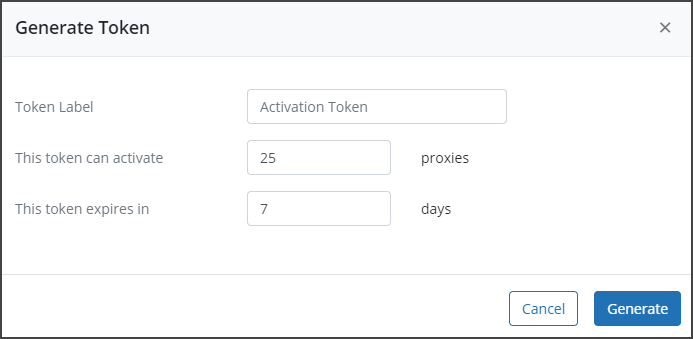
- In the Generate Token dialog box, click Done.
- Select the newly generated token from the drop-down list under Activation Token.
- In the Activate Proxy section, under Windows Server, click Copy Command to copy the activation command.
- On the Windows server, open the command prompt and navigate to:
- C:\Program Files\Druva\Phoenix Agent (for agent version prior to 7.0.0)
- C:\Program Files\Druva\EnterpriseWorkloads (for agent version 7.0.0 and later)
- Paste the command and press Enter. You can also append the server name by editing the command:
- For Druva Cloud:
HybridWorkloadsAgent.exe nas activate -t <token> -n <ProxyName> (for agent version prior to 7.0.0) EnterpriseWorkloadsAgent.exe nas activate -t <token> -n <ProxyName> (for agent version 7.0.0 and later)
For example: HybridWorkloadsAgent.exe nas activate -t 67831-228-1762-591132241ce4fb2e14fca792cbf532f4a2359eb0bf1b96f82211373ebea7c23b -n WIN-RTG3 (for agent version prior to 7.0.0) EnterpriseWorkloadsAgent.exe nas activate -t 67831-228-1762-591132241ce4fb2e14fca792cbf532f4a2359eb0bf1b96f82211373ebea7c23b -n WIN-RTG3 (for agent version 7.0.0 and later)
- For Druva Cloud:
where <token> represents the activation token that Druva generated at the time of registering server.
- For GovCloud:
HybridWorkloadsAgent.exe nas activate –g -t <token> -n <ProxyName> (for agent version prior to 7.0.0) EnterpriseWorkloadsAgent nas activate -t <token> -n <ProxyName> (for agent version 7.0.0 and later)
For example: HybridWorkloadsAgent.exe nas activate -g -t 67831-228-1762-591132241ce4fb2e14fca792cbf532f4a2359eb0bf1b96f82211373ebea7c23b -n WIN-RTG3 EnterpriseWorkloadsAgent.exe nas activate -g -t 67831-228-1762-591132241ce4fb2e14fca792cbf532f4a2359eb0bf1b96f82211373ebea7c23b -n WIN-RTG3
| Field | Description |
|---|---|
| token (-t, --token string) |
Paste the copied activation.
|
| ProxyName (-n, --ServerDisplayName string) |
Enter a unique proxy name in the current Organization for each workload of the same type. |
| GovCloud ( -g, --gov-cloud) |
Enable GovCloud. |
In both the above commands, <activation token> is the activation token of the NAS proxy.
The NAS proxy name is not case-sensitive. You cannot have one NAS proxy registered as "ABC" and another as "abc". Druva will display the error message "Server display name already exists. Cannot register the server with same display name."
- If you’re using the Enterprise Workloads Agent shortcut to activate the agent, click Copy Token.
- Double-click the Enterprise Workloads Agent shortcut on the Windows server where the Enterprise Workloads Agent needs to be activated.
The Enterprise Workloads Agent window is displayed.
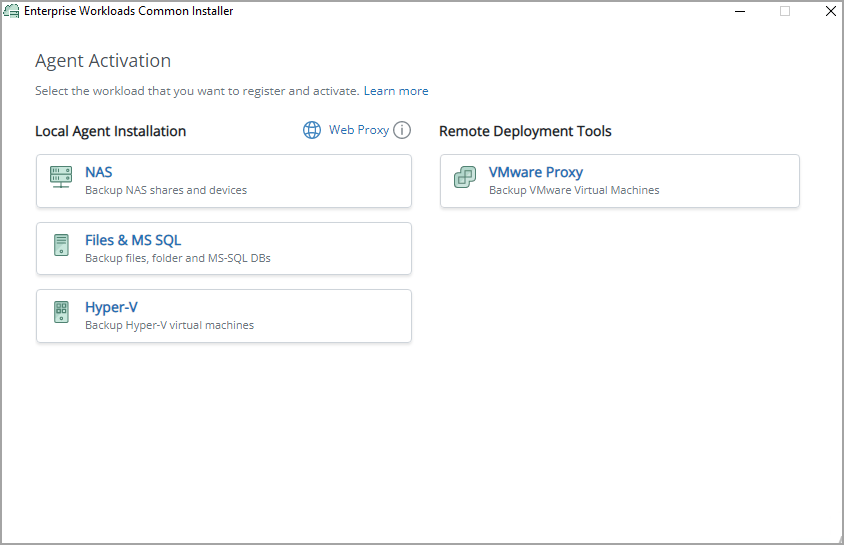
- In the Enterprise Workloads Agent window, select NAS to activate.
- Select the type of Cloud deployment: Public Cloud or Gov Cloud.
- A set of in-built activation checks are run and the result is displayed. Click Next.
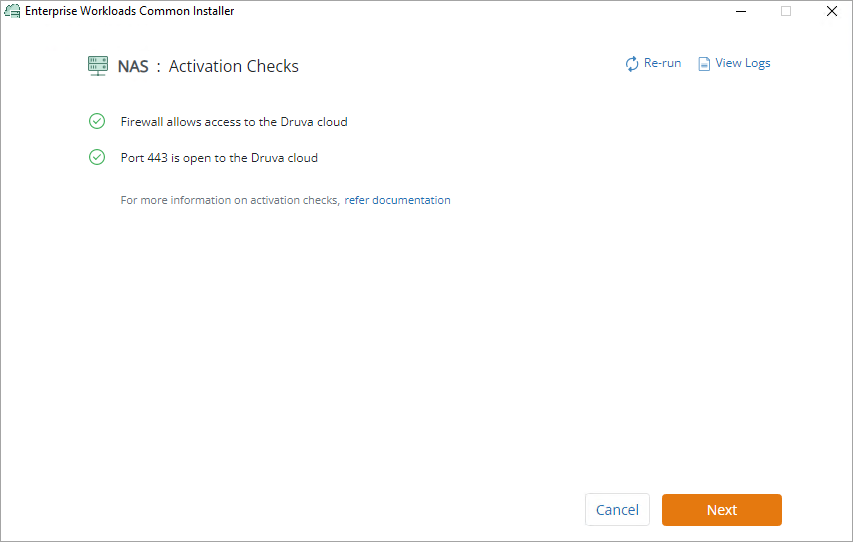
- The Agent Activation page for NAS is displayed.
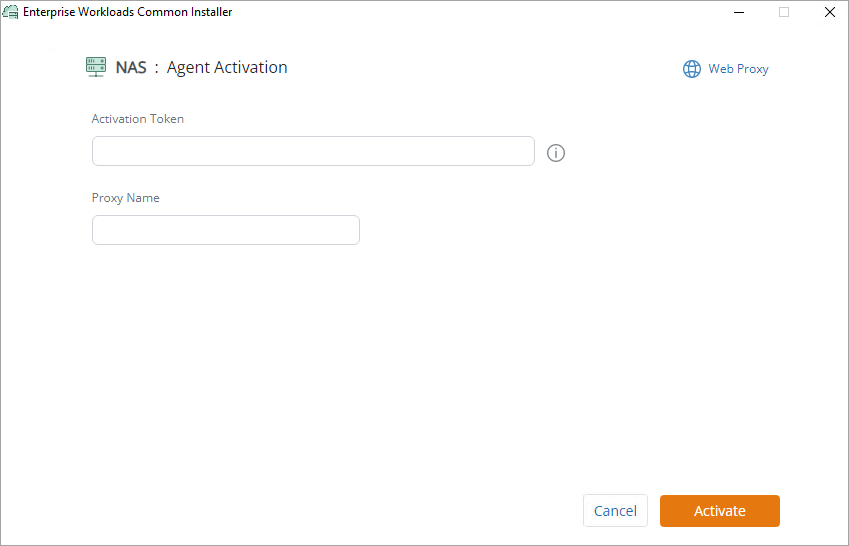
- Enter the following details:
- Double-click the Enterprise Workloads Agent shortcut on the Windows server where the Enterprise Workloads Agent needs to be activated.
| Field | Description |
|---|---|
| Activation Token | Paste the copied activation token.
Note: This is the token copied from the Add NAS Proxy dialog box. |
| Proxy Name | Enter a unique proxy name in the current Organization for each workload of the same type.
Note: The proxy name should not contain any special characters. |
Note: If you are activating the Phoenix agent for Druva Public Cloud, do not select the GovCloud check box.
- Click Activate.
The backup readiness checks will run to ensure that your system is equipped for successful backup operation.
The NAS agent is activated successfully.Note: After successful activation, a green tick displays next to the workload on the mentioned common agent activation screen.
Activating the NAS proxy on a Linux Server
-
In the Add NAS Proxy wizard, under the Activate Proxy section, select a valid activation token. An activation token can be used to activate up to 25 NAS proxies and expires in 7 days. If all activation tokens have expired, Druva creates a Default Activation Token automatically when you click Add Proxy. If you want to create a new token, perform the following tasks:
-
Click Generate New Token to create a new token.
-
In the Generate Token dialog box, enter the following details, and click Generate.

-
In the Generate Token dialog box, click Done.
-
Select the newly generated token from the drop-down list under Activation Token.
-
In the Activate Proxy section, under Linux/Ubuntu Server, click Copy Command to copy the activation command.
- On the Linux server, open the terminal and navigate to
opt/Druva/Phoenix/bin (for agent version prior to 7.0.0)
cd /opt/Druva/EnterpriseWorkloads/bin (for agent version 7.0.0 and later)
- Paste the copied command as explained below:
-
Public Cloud
HybridWorkloadsAgent nas activate -t <token> -n <ProxyName> (for agent version prior to 7.0.0)) EnterpriseWorkloadsAgent nas activate -t <token> -n <ProxyName> (for agent version 7.0.0 and later)
For example: HybridWorkloadsAgent nas activate -t 67831-228-1762-591132241ce4fb2e14fca792cbf532f4a2359eb0bf1b96f82211373ebea7c23b -n WIN-RTG3 EnterpriseWorkloadsAgent nas activate -t 67831-228-1762-591132241ce4fb2e14fca792cbf532f4a2359eb0bf1b96f82211373ebea7c23b -n WIN-RTG3
-
GovCloud
HybridWorkloadsAgent nas activate –g -t <token> -n <ProxyName> (for agent version prior to 7.0.0) EnterpriseWorkloadsAgent nas activate -g -t <token> -n <ProxyName> (for agent version 7.0.0 and later)
For example: HybridWorkloadsAgent nas activate -g -t 67831-228-1762-591132241ce4fb2e14fca792cbf532f4a2359eb0bf1b96f82211373ebea7c23b -n WIN-RTG3 EnterpriseWorkloadsAgent nas activate -g -t 67831-228-1762-591132241ce4fb2e14fca792cbf532f4a2359eb0bf1b96f82211373ebea7c23b -n WIN-RTG3
-
-
In both the above commands, <activation token> is the activation token of the NAS proxy.
The NAS proxy name is not case-sensitive. You cannot have one NAS proxy registered as "ABC" and another as "abc". Druva will display the error message "Server display name already exists. Cannot register the server with same display name."


